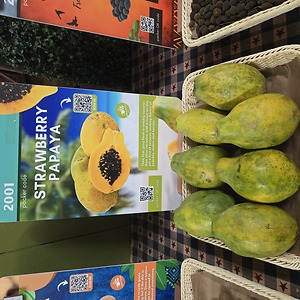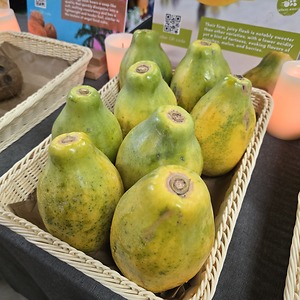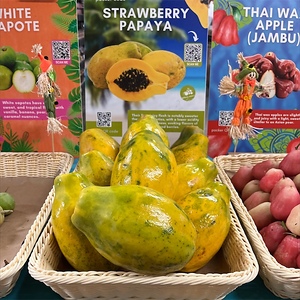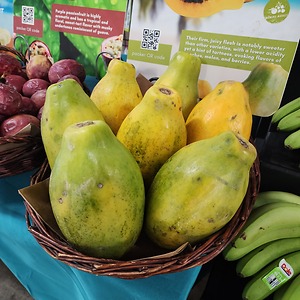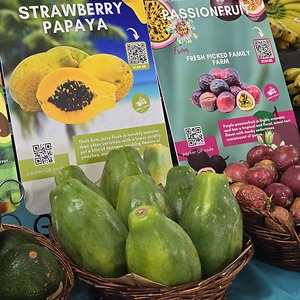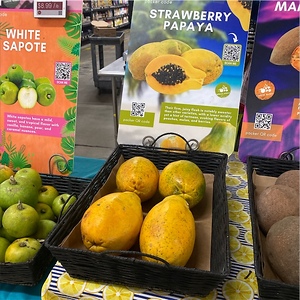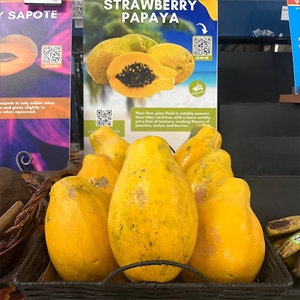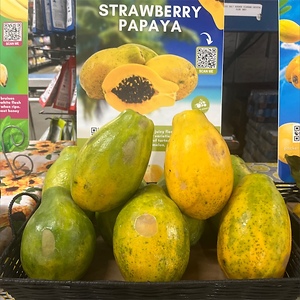

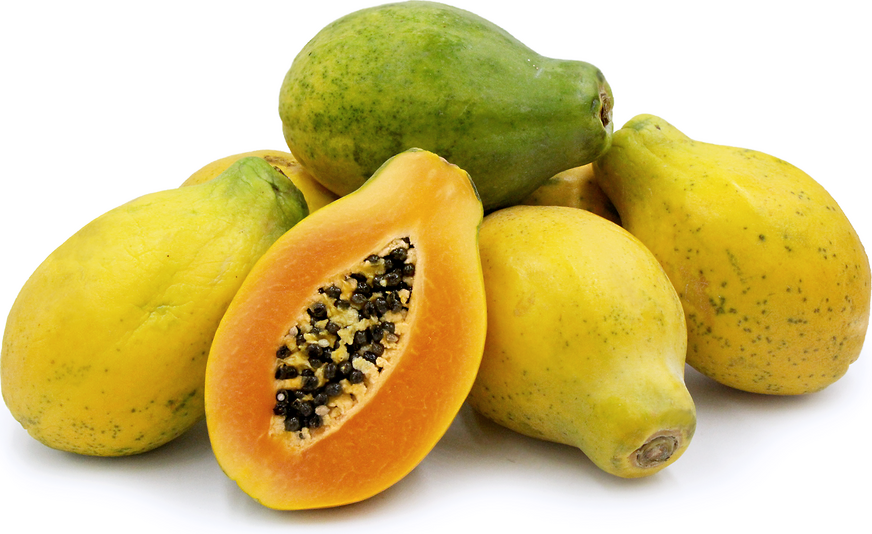
Strawberry Papaya (Sunrise)
Estimated Inventory, 10 ct : 0
This item was last sold on : 06/04/25
Description/Taste
Strawberry papayas are a tropical fruit that flourish on hollow-stemmed trees. These fruits have an elongated pear shape, typically ranging from 15 to 30 centimeters in length and 10 to 20 centimeters in diameter. As they ripen, their smooth, leathery skin transitions from a golden-orange to lime green hude, often displaying a gradient of both colors. Inside, the salmon-pink flesh surrounds a shallow, oblong seed cavity filled with numerous small, shiny, black seeds that are inedible but easily removed due to the less indented cavity compared to other papayas. Known for their distinctive sweet and tropical aroma, the scent of Strawberry papayas is reminiscent of a mix of melon and berries, particularly strawberries—a characteristic that inspired their name. Their firm, juicy flesh is notably sweeter than other varieties, with a lower acidity yet a hint of tartness, evoking flavors of peaches, melon, and berries.
Seasons/Availability
Strawberry papaya is available year-round.
Current Facts
The botanical name for the Strawberry Papaya is Carica papaya and it’s a member of the Caricaceae family. It is also known as the Sunrise Papaya. Papayas are typically categorized as either Mexican or Hawaiian. Mexican papayas are quite large with a milder flavor, while Hawaiian varieties, like the Strawberry Papaya, are smaller and notably sweeter. This Hawaiian variety emerged from the hybridization of the Solo papaya, a strain celebrated for its reddish-orange and exceptionally sweet flesh. Papayas yield a valuable byproduct known as papain. Extracted from the potent enzymes in the papaya skin, papain has been used as a meat tenderizer in South America well before gaining global culinary recognition. Just a teaspoon of this plant-based powder can soften tough cuts of meat, imparting a "melt in your mouth" sensation ideal for dishes like steak kabobs. Growing papaya trees requires light, well-drained soil that should remain moist in hot weather and dry in cooler conditions, as the trees are vulnerable to excess moisture. This sensitivity makes cultivation challenging in places like California, where rainfall patterns do not comply with these needs, thus necessitating the use of plastic coverings to grow papaya trees in such regions.
Nutritional Value
Strawberry papayas are a rich source of beta carotene, a potent antioxidant and type of carotenoid that the body converts into vitamin A. This vitamin is crucial for maintaining healthy skin, mucous membranes, robust immune function, and optimal eye health and vision. Strawberry papayas provide a wealth of vitamins A, C, E, and K, which collectively enhance immune function, reduce the risk of chronic diseases, support skin health, and promotes normal blood clotting. Strawberry papayas are also abundant in potassium and magnesium, essential nutrients that support heart and bone health, muscle function, energy production, and psychological well-being. The papain enzyme, found in raw papaya skin, contains properties that may help fight infections and heal wounds, and has been traditionally used to treat conditions such as cavities, shingles, parasitic infections, jellyfish stings, and wounds. It is important to note that consuming unripe Strawberry papayas can pose risks, such as causing premature labor in pregnant women. Individuals with latex allergies should avoid all types of papaya, as they may experience allergic reactions.
Applications
Strawberry papayas can be eaten raw, dried, or cooked. For a simple treat, they can be halved and eaten with a squeeze of fresh lime or chopped and mixed with other tropical fruits. Sliced Strawberry papaya adds a vibrant touch to salads. They are often pureed into tropical juices and smoothies. The papain extracted from Strawberry papayas serves as an effective meat tenderizer, although it should be used sparingly to prevent the proteins from breaking down into a grainy texture. Strawberry papayas excel in Asian cuisine, enhancing dishes like Thai salads, Vietnamese spring rolls, Indian chutneys, sushi, and stir-fries. Cubes of Strawberry papaya can be combined with pineapple, peppers, pearl onions, and tomatoes to create unique fruit kabobs for grilling. When dried and coated in sugar, Strawberry papayas transform into delicious gummy candies. Complementary flavors include bananas, coconut, kiwi, citrus, mango, passion fruit, pineapple, ginger, cinnamon, vanilla, cilantro, black pepper, shrimp, prosciutto, cashews, and macadamia nuts. Strawberry papayas are ripe when they feel soft to the touch. Before consumption, remove the small black seeds from the center. To ripen green fruits, leave them at room temperature for three to five days. They can then be stored in the refrigerator for up to one week.
Ethnic/Cultural Info
The development of the Strawberry papaya at the University of Hawaii marked a significant breakthrough in agricultural science, blending innovative breeding techniques with meticulous cultivation to produce vibrant new varieties. Launched in the early 1960s, the project aimed to enhance papaya strains with better flavor, color, and disease resistance. Researchers crossed the sweet, yellow-fleshed 'Kariya' papaya, which lacked disease resistance, with the resilient, deep red 'Line 9' solo strain. This led to the creation of two distinct cultivars: Sunrise, known for its strawberry-like, orange-red flesh, and Sunset, which boasts a deeper red hue and richer flavor. The United States is the largest importer of papayas, primarily sourcing from Mexico, Belize, Guatemala, Brazil, and the Dominican Republic. A significant portion of the U.S. papaya production occurs in South Florida, where the subtropical climate allows year-round cultivation.
Geography/History
Originally developed in Hawaii, Strawberry papaya is now cultivated in other tropical regions including Mexico, Puerto Rico, Florida, Southern California, and Brazil. These areas offer the ideal tropical and subtropical climates that Strawberry papayas require—abundant sunshine, warmth, and a frost-free environment. Primarily grown in controlled agricultural settings rather than in the wild, Strawberry papayas are most commonly found on large-scale commercial farms but are also cultivated in home gardens within suitable climates. Since its emergence in the 1960s, Strawberry papaya has gained popularity beyond Hawaii due to its ability to thrive in tropical regions and its resistance to certain diseases, making it a favored choice for farmers. Strawberry papayas are readily available in areas with large populations or a high demand for diverse fruit varieties, such as urban centers or regions near papaya-growing areas. You can find them in grocery stores, farmers' markets, and specialty stores. In appropriate climates, individuals may also grow Strawberry papayas in their home gardens.
Recipe Ideas
Recipes that include Strawberry Papaya (Sunrise). One



